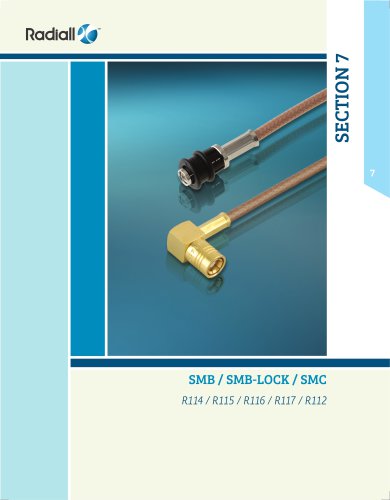
カタログの抜粋

10 GBPS MULTIPLE CHANNEL OPTICAL TRANSCEIVERS FOR HARSH ENVIRONMENT APPLICATIONS Alexis COLLIER, William STADTLER, Mathias PEZ Radiall-USA Inc. 104 John W. Murphy Drive, 06513 New Haven CT, USA Abstract This paper presents the challenges of designing 10Gbps parallel optical transmitters and receivers for harsh environment applications. We summarize also the main key performances demonstrated on D-Lightsys 12 channel optical transmitters and receivers. Introduction The avaliability of reliable FPGA's integrated SERDES (Serializer & Deserializer) compatbile with bit rate from 10 Gbps and up opens system designers new performances horizons for their applications. In order to sustain the bit rate over link length greater than few tens of inches, the use of optical interconnects becomes mandatory. Radiall/D-Lightsys recently introduce high performances 10 Gbps optical transceivers and 12 channels transmitters and receivers to fullfil the FPGA bit rates chalenges. D-Lightsys integrated design offers serveral key features for improved link performances, such as a large optical link budget or low power consumption, an extended temperature range or pre/post-equalization functions. we present in this paper the chalenges of designing a high performances optical link for harsh environment applications as the main performances achieved by D-Lightsys products. 10 Gbps Optical Communication Chalenges Operations at 10Gbps are quite chalenging as the wavelength is the same order of magnitude as the board tracks or greater, which make them sensitive to impedance mis-match, dielectric constant variation, electrical reflection and crosstalk. An appropriate and accurate layout as high frequency board materials shall be used. When links length increase the design becomes crosstalk sensitive and could generate interferences. For length greater than a few meters the use optical links becomes mandatory. The main difference with RF signals is the occupied frequency band by the digital signals: digital signals occupy the whole frequency band from DC to one or several times the Bit Rate (BR), according to the rise & fall time specifications. Rapid transitions are potential sources of interferences and shall be limited but not at the cost of the overal link performances. 10 Gbps optical transceivers shall be designed to minimize signal crosstalk and to provide sharp rise and fall times to the SERDES to simplify the clock recovery circuit and minimize the Bit Error Rate of the link (BER). State of the Art Vertical Cavity Surface Emitting Lasers (VCSELs) with modulation bandwidth greater than 10GHz could be found on the market with high TRL levels. Theses VCSELs presents a frequency response largely dependant on the biasing point of the laser: the larger the biasing is the larger the bandwidth is. For low biasing current, the frequency response presents a resonance peak that could create large overshoots or ringing on the optical eye. This ringing risks is present at low biasing current and degrade the optical eye considerably if not taken into account in the design. In order to reduce this risk and to improve performances, it is preferable to operate the VCSEL with large biasing current and reduced modulation current. Indeed the receiver sensitivity is linearly dependant on the average optical power, i.e. 1dB increase in the average optical power directly translate to 1dB on the receiver sensitity. Althougth for Extinction Ratio (ER) greater than 6dB, and increase of 2dB in the E R is equivalent of an increase of only 1dB in the sensitivity. Radiall/D-Lightsys Optical Transceiver Main Performances The system key performance for an optical link is the Link Budget (LB): the larger is the LB, the more disconnects and/or link losses the system will be able to handle. This is even more critical in harsh or Mil/aero environments were disconnect are numerous and succeptible to large number of mating and unmating procedures. D-Lightsys developped, thanks to its experience in ruggedized and robust design transceivers, a suite of 10Gbps optical modules suitable for harsh environments: S-Light and D-Light families have been enriched with a 10Gbps release. Products are pin to pin compatble with their lower bit rate equivalent. They present state of the art optical performances and withstand larger level of vibe and shocks and they can operate in extended temperature ranges. Thanks to the optimization of some key parameters presented below, we have been able to demonstrate 12dB of link budget at 10Gbps fort both module family.
カタログの1ページ目を開く
1. Optical Eye diagrams The optical eye diagram demonstrates the transmitter key performances: Laser extinction ratio, based on experience an ER of 6dB is key for performances. The transmitter Jitter The ability to pass standard masks, that demonstrate a BER compatibilility. (a) Transmitter (b) Receiver Fig. 2 - D-Lightsys Eye Diagram @ 10Gbps and 90oC 2. Link Jitter Performances The link jitter performance is the results of the transmitter and the receiver jitter generation, it will determine or impact the FPGA ability to recover properly the clock and decode without error the data...
カタログの2ページ目を開くRadiallのすべてのカタログと技術パンフレット
-
DSX SERIES
64 ページ
-
Optical Transceivers
4 ページ
-
Radiall catalog
24 ページ
-
MML
22 ページ
-
MMBX
24 ページ
-
Coaxipack 2 & Inserts
16 ページ
-
BMR-Spring
24 ページ
-
BMA
54 ページ
-
Corrugated
39 ページ
-
RTX Series (EN3716)
17 ページ
-
MM & MB Series
35 ページ
-
B & MCSR Series
27 ページ
-
MMC Series
37 ページ
-
NSX Series (ARINC 600)
113 ページ
-
QM Series
33 ページ
-
EPX Series
67 ページ
-
Attenuators
7 ページ
-
Power Terminations
2 ページ
-
low PIM switches
2 ページ
-
Space section
16 ページ
-
RF test probes
2 ページ
-
QLI connector
2 ページ
-
SMP-LOCK
2 ページ
-
Quick Multipin Series
34 ページ
-
Coaxial Devices
23 ページ
-
Coaxial Switching Products
188 ページ
-
QPL Connectors
4 ページ
-
Multiport Connectors
17 ページ
-
High Voltage Connectors
23 ページ
-
Fakra-USCAR Series
37 ページ
-
Adapter
31 ページ
-
Coaxial Couplers
25 ページ
-
Coaxial Switching Products
168 ページ















































































